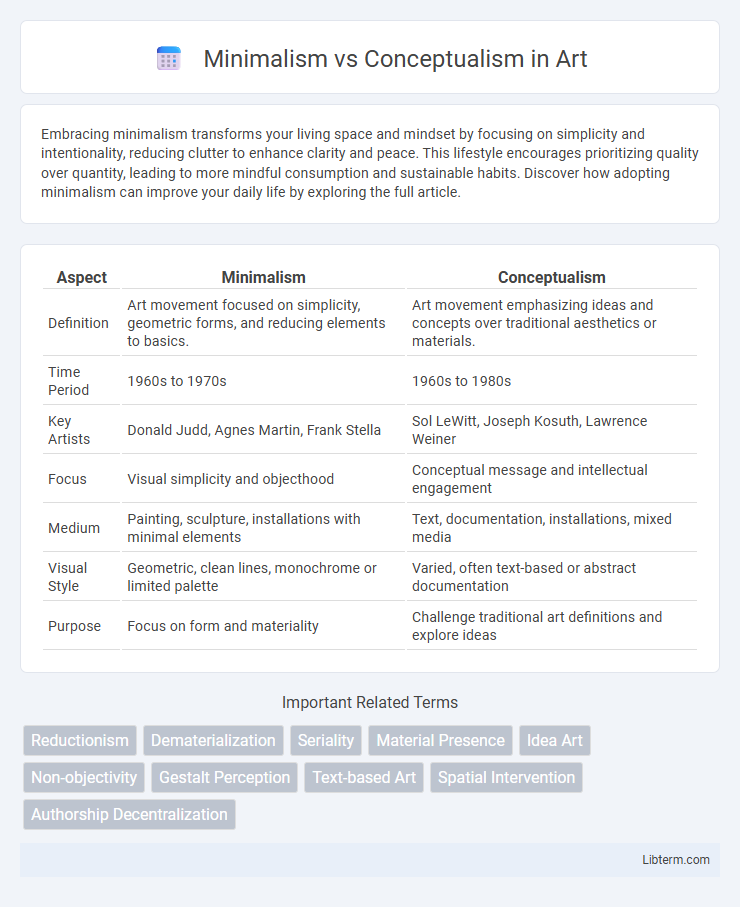Embracing minimalism transforms your living space and mindset by focusing on simplicity and intentionality, reducing clutter to enhance clarity and peace. This lifestyle encourages prioritizing quality over quantity, leading to more mindful consumption and sustainable habits. Discover how adopting minimalism can improve your daily life by exploring the full article.
Table of Comparison
| Aspect | Minimalism | Conceptualism |
|---|---|---|
| Definition | Art movement focused on simplicity, geometric forms, and reducing elements to basics. | Art movement emphasizing ideas and concepts over traditional aesthetics or materials. |
| Time Period | 1960s to 1970s | 1960s to 1980s |
| Key Artists | Donald Judd, Agnes Martin, Frank Stella | Sol LeWitt, Joseph Kosuth, Lawrence Weiner |
| Focus | Visual simplicity and objecthood | Conceptual message and intellectual engagement |
| Medium | Painting, sculpture, installations with minimal elements | Text, documentation, installations, mixed media |
| Visual Style | Geometric, clean lines, monochrome or limited palette | Varied, often text-based or abstract documentation |
| Purpose | Focus on form and materiality | Challenge traditional art definitions and explore ideas |
Introduction to Minimalism and Conceptualism
Minimalism emphasizes simplicity, reducing art to its essential forms using geometric shapes, limited colors, and repetition to create an objective experience. Conceptualism prioritizes ideas over aesthetic, where the concept or meaning behind the artwork holds greater significance than the physical object itself. Both movements challenge traditional art by shifting focus from visual complexity to intellectual engagement and interpretation.
Origins and Historical Context
Minimalism emerged in the 1960s, primarily in the United States, as a reaction against the emotional intensity of Abstract Expressionism, emphasizing simplicity, geometric forms, and industrial materials to create art focused on pure form and space. Conceptualism also arose in the 1960s as a challenge to traditional art objects, prioritizing ideas and concepts over aesthetic or material concerns, with origins tied to earlier avant-garde movements like Dada and Fluxus. Both movements reflect a shift towards intellectual engagement in art, but Minimalism roots itself in reductive aesthetics while Conceptualism centers language, instruction, and the dematerialization of the art object.
Key Philosophies and Principles
Minimalism emphasizes simplicity, focusing on essential forms, clean lines, and the reduction of elements to achieve clarity and purity in art. Conceptualism prioritizes ideas over aesthetics, where the significance lies in the conceptual message or intellectual engagement rather than the physical artwork. Both movements challenge traditional art by redefining value through form in Minimalism and through meaning in Conceptualism.
Iconic Artists and Works
Minimalism, championed by artists like Donald Judd and Agnes Martin, emphasizes simplicity, geometric forms, and the use of industrial materials as exemplified in Judd's "Untitled" (1969) and Martin's "Friendship" series. In contrast, Conceptualism prioritizes ideas over aesthetic form, with pioneers such as Sol LeWitt and Joseph Kosuth whose works like LeWitt's "Wall Drawing #1136" (2004) and Kosuth's "One and Three Chairs" (1965) challenge traditional art definitions through language and concept. Both movements revolutionized contemporary art by stripping away traditional distractions, focusing respectively on form and concept to provoke deeper viewer engagement.
Visual Aesthetics: Comparing Styles
Minimalism emphasizes simplicity and purity of form through geometric shapes, clean lines, and limited color palettes, aiming to create a visually calm and uncluttered experience. Conceptualism prioritizes ideas over pure visual form, often incorporating text, symbols, or mixed media to provoke thought and challenge traditional aesthetic norms. The visual aesthetics of Minimalism rely on reduction and spatial harmony, while Conceptualism uses visual elements as tools to convey deeper meanings beyond surface appearance.
Materials and Techniques Used
Minimalism emphasizes the use of industrial materials such as steel, glass, and concrete, often employing precise, repetitive fabrication techniques that highlight simplicity and geometric forms. Conceptualism prioritizes ideas over aesthetics, frequently using ephemeral or unconventional materials like text, found objects, and mixed media, with techniques centered on documentation, performance, or installation to convey meaning. The contrast lies in Minimalism's focus on physical presence and material integrity versus Conceptualism's reliance on intellectual engagement and conceptual processes.
Viewer Experience and Interpretation
Minimalism emphasizes simplicity and objective forms, encouraging viewers to engage with the physical presence and spatial relationships of the artwork, fostering a direct sensory experience. Conceptualism prioritizes ideas over aesthetic form, inviting viewers to interpret underlying concepts and question the nature of art itself, often requiring intellectual engagement and critical thinking. The viewer's experience in Minimalism is rooted in perception and materiality, while in Conceptualism it centers on meaning and context.
Influence on Contemporary Art
Minimalism emphasized simplicity, geometric forms, and the reduction of art to its essentials, significantly impacting contemporary art by inspiring artists to focus on materiality and spatial relationships. Conceptualism shifted the focus from aesthetic form to ideas, prioritizing intellectual engagement and the dematerialization of the art object, thus influencing contemporary practices that value concept over visual appearance. Both movements challenged traditional art boundaries, encouraging experimentation and expanding definitions of art in the contemporary scene.
Criticisms and Controversies
Minimalism faces criticism for its perceived austerity and lack of emotional depth, often labeled as overly simplistic or detached from social context. Conceptualism encounters controversies over its intangibility and reliance on intellectual engagement, leading some critics to argue it alienates viewers through obscurity and elitism. Both movements spark debates on the balance between form and meaning, challenging traditional art values and audience accessibility.
Which Movement Resonates Today?
Minimalism's emphasis on simplicity and functional design continues to resonate strongly in today's digital and sustainable lifestyles, appealing to those valuing clarity and efficiency. Conceptualism attracts audiences drawn to intellectual engagement and deeper social commentary through art, reflecting contemporary interests in ideas and critical thinking. Current trends show a blend where minimalism's aesthetic purity meets conceptualism's thought-provoking narratives, highlighting a dynamic interplay between form and meaning in modern creativity.
Minimalism Infographic

 libterm.com
libterm.com